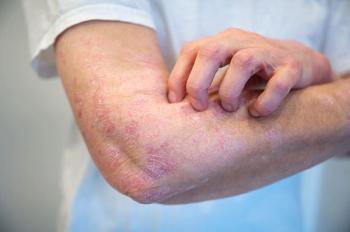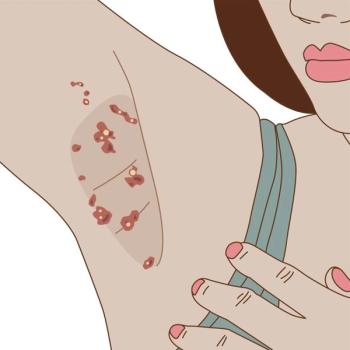
A Man With a Refractory Groin Rash
A 51-year-old man is seen because of a painful groin rash. Has not cleared despite 3 months’ topical corticosteroids and antifungals.
HISTORY
A 51-year-old man is seen because of a painful groin rash. Has not cleared despite 3 months’ topical corticosteroids and antifungals. Does not have diabetes but does abuse alcohol and has alcoholic cardiomyopathy; obese.
PHYSICAL EXAMINATION
Normal vital signs. Malodorous rash in groin, from upper thigh across inguinal crease and onto medial scrotum. Includes shallow erosions, especially on scrotum, and fine scale, especially at upper margin and deepest in inguinal recess.
WHAT'S YOUR DIAGNOSIS?
WHAT'S YOUR DIAGNOSIS?
ANSWER: ERYTHRASMA
Red-purple discoloration coats the most medial portion of the patient’s right thigh, and the adjacent scrotum and root of the penis (he is retracting his own penis and scrotum to our right, to spread apart the skin and show the lesions). The most distal scrotal skin looks white and as though there is the beginning of lichenification. Several shallow, irregular erosions seem to be grouped vertically; their appearance suggests that they are painful. Most clinicians, myself included, would first call this a familiar if not utterly typical fungal infection of skin.
A potassium-hydroxide (KOH) preparation of skin scrapings showed no hyphae or recognizable yeasts. Examination under a Wood’s light showed the coral-red color (Figure) from coproporphyrin III production due to infection with Corynebacterium minutissimum, establishing a diagnosis of erythrasma. Was this a purely laboratory diagnosis, or could we have reached it clinically?
HOW EASY TO BE MISLED
Despite persistence beyond adequate antifungal therapy, many of us would be inclined to consider this process mycotic. We’d postulate noncompliance, poor hygiene or, failing those, fungal resistance to the agents utilized-a sequence that while not unreasonable can be lampooned as “If you are stuck, blame the patient; if that does not stick, blame the germ.” We might try a systemic antifungal such as oral terbinafine, notwithstanding its potential for serious side effects.1 Our thinking would be mistaken; some bedside clues could widen our differential diagnosis if we are alert to alternatives, and if we realize that even ineffective treatment will alter lesion morphology.
MOST PROMINENT DIFFERENTIAL: FUNGI
This area of skin could readily pass for intertriginous candidal infection. The erosions, likely resulting from excoriation, reinforce that impression, as does the sense- much easier to confirm or refute if we had the actual patient to touch with a gloved hand-of slight elevation and infiltration of the dermis, producing a plaque with a bit of induration. What is missing from a classic picture of candidal infection is any surface exudate and any pustular element, but neither of these features is invariable with Candida; all the more so if, as above, therapy has suppressed infection without cure.
The slightly serpiginous border on the thigh, at our left, could be taken as indicative of tinea cruris. Some edema is inferred from loss of the wrinkles on the lateral border of the scrotum; some whitening, inferior to the erosions, suggests scarring since it is not, clearly, merely a residue of medicine as the white grainy matter at the base of the inguinal crease may be (though that may also be residues of sebum).
All this, along with the infiltrative quality, makes one consider a process that is less purely superficial than erythrasma. In fact, we do see some deeper change: the effects of scratching.
A lesion that is more intensely red strongly favors fungi; so do serpentine borders and more prominent scaling at the border. In this case a rather uniform dull–dark purplish red remains, obscuring the original color. There is no central clearing, a key feature typical of tinea and not expected in erythrasma.2-4 Locale also aids interpretation: tinea versicolor does not favor intertriginous areas whereas erythrasma does.
ROLE OF WOOD’S LIGHT
Many primary care clinicians have no Wood’s light. So one wants not to pin everything on it: then we become over-dependent on the dermatologist. But Wood’s lights are now available at low cost. For the Wood’s light examination to be reliable, the area ought not be washed during the preceding 12 hours so that bacterial porphyrins can become sufficiently abundant to be visualized. We need to look without topical medicines in place: they can mask or mimic pathology. Our chief distinction with the Wood’s light in this matter is between the yellow of many tineal species, and the coral-red of erythrasma.
Some published cases of non-fluorescing erythrasma might reflect failure of porphyrin synthesis, so we cannot dogmatically equate erythrasma and coral color.
Conversely, because some pigment may persist in the stratum corneum, fluorescence can still be seen, in some cases, for some time after microbiologic cure. Add this to the sometime presence of C minutissimum in normal skin flora, and the frequently negative cultures in clinically definite cases, and the difficulty in making firm scientific connections is underscored.
RESPONSE TO INTERVENTIONS
Although the infection is bacterial, sometimes topical azoles used for fungal infections prove curative, a reassuring thought when I contemplate how many cases of erythrasma I have mislabeled as fungal over the years. Antibacterials are also effective, both topically and systemically.5 So is twice-daily vigorous lathering and rinsing with antibacterial soap.6 A benzoyl peroxide shower bar is advocated, and one study suggests that this might suffice as monotherapy- a real advantage for patients with no resources, given that universal coverage is not achieved with any of the so-called health care reform bills before Congress.
Some brilliant clinicians capitalized on the production of toxic oxygen species by porphyrins exposed to defined wavelengths of light, with varied cure rates to date7 but with much promise for the future.
CUTANEOUS CORYNEBACTERIOSES
The groin, axillae, and feet are the usual sites of erythrasma. On the feet, the condition most often affects the web spaces of toes and the soles of those who wear heavy footgear and experience maceration of sweaty skin.1,4 Between the toes, erythrasma typically produces hyperkeratotic white-yellow plaque, with some scaling.2 Craters within such lesions on weight-bearing skin of the feet suggest another corynebacterial dermatosis, pitted keratolysis.4 A last corynebacterial dermatosis is misnamed trichomycosis axillaris, though it is not mycotic and can occur in pubic as well as armpit hair: the bacteria form a biofilm about the hairs, and the patient is likely to complain that some deodorant would not wash off, for that is what it looks like, and that the armpits smell stronger and worse.
Erythrasma in perianal skin commonly produces pruritus ani.8 Many reddish brown patches around the anus are ignored as simply the normal darker tone of perianal (as of genital) skin or, worse, remnants of fecal staining. Except for its commonly being asymptomatic, and sometimes spontaneously resolving, underdiagnosis of erythrasma in general, and at this site in particular, could lead to considerable misery. Undoubtedly many patients suffer in silence due to mortifying embarrassment about the locale, even more so if they dread that investigation will uncover something “shameful” such as worms, a link to sexual behavior, or something to do with bowel habits, bowel fixation, or manner of cleaning and wiping the bottom.
SYSTEMIC ISSUES
When erythrasma of the feet produces cracking between the toes, it becomes a portal of entry for bacterial cellulitis of the foot, but the complication is almost always due to different genera, typically streptococci or Staphylococcus aureus organisms.
The same genus, Corynebacterium, can produce diphtheria, a lethal disease both via its strategic locale at the pharynx and via production of a toxin that can damage the heart,9 so one cannot simply dismiss the corynebacteria as insignificant pathogens. The J-K bacillus in the immunodebilitated is also corynebacterial, and there have been isolated cases of C minutissimum bacteremia in immunocompromised patients.10
EFFECT ON HOST AND ON SOCIETY
For those afflicted merely with a discolored patch of erythrasma in a typical area, key issues are cosmetic effect, and impact on quality of life including pain and pruritus if any. We can avoid continuing treatment of a misdiagnosed case with antifungals by reviewing effects of treatment with an open mind; protracted erroneous management wastes time and money, frustrates all parties, encourages microbial resistance, and provides selection pressure to change systemic flora to ever more resistant strains. In the best outcome of such a case, namely resolution, we experience false “confirmation” of our mistaken diagnosis because our medication eradicated a different microbe than our suspect, or because the process departed as mysteriously as it had arrived.
Schneiderman H. Erythrasma: a bacterial infection that looks fungal. CONSULTANT. 2010;50:81-85.
References:
REFERENCES:1. Uwaifo GI, Schneiderman H, Daman LA. Toxic epidermal necrolysis (in this case related to terbinafine): a lethal dermatologic emergency. Consultant. 1999;39:1147-1167.
2. Lee PK, Weinberg AN, Swartz MN, Johnson RA. Pyodermas: Staphylococcus aureus, Streptococcus, and other Gram-positive bacteria. In: Freedberg IM, Eisen AZ, Wolff K, et al, eds. Dermatology in General Medicine. 5th ed. New York: McGraw-Hill Book Company; 1999:2203-2205.
3. Laube S, Farrell AM. Bacterial skin infections in the elderly: diagnosis and treatment. Drugs Aging. 2002;19:331-342.
4. Blaise G, Nikkels AF, Hermanns-Le T, et al. Corynebacterium-associated skin infections. Int J Dermatol. 2008;47:884-890.
5. Hamann K, Thorn P. Systemic or local treatment of erythrasma? A comparison between erythromycin tablets and Fucidin cream in general practice. Scand J Prim Health Care. 1991;9:35-39.
6. Dodge BG, Knowles WR, McBride ME, et al. Treatment of erythrasma with an antibacterial soap. Arch Dermatol. 1968;97:548-552.
7. Darras-Vercambre S, Carpentier O, Vincent P, et al. Photodynamic action of red light for treatment of erythrasma: preliminary results. Photodermatol Photoimmunol Photomed. 2006;22:153-156.
8. Smith LE, Henrichs D, McCullah RD. Prospective studies on the etiology and treatment of pruritus ani. Dis Colon Rectum. 1982;25:358-363.
9. Schneiderman H. Diphtherial pharyngitis: the most ominous cause. Consultant. 1991;31(5):51-52.
10. Rupp ME, Stiles KG, Tarantolo S, Goering RV. Central venous catheterrelated Corynebacterium minutissimum bacteremia. Infect Control Hosp Epidemiol. 1998;19:786-789.
Newsletter
Enhance your clinical practice with the Patient Care newsletter, offering the latest evidence-based guidelines, diagnostic insights, and treatment strategies for primary care physicians.















































































































































































































































































